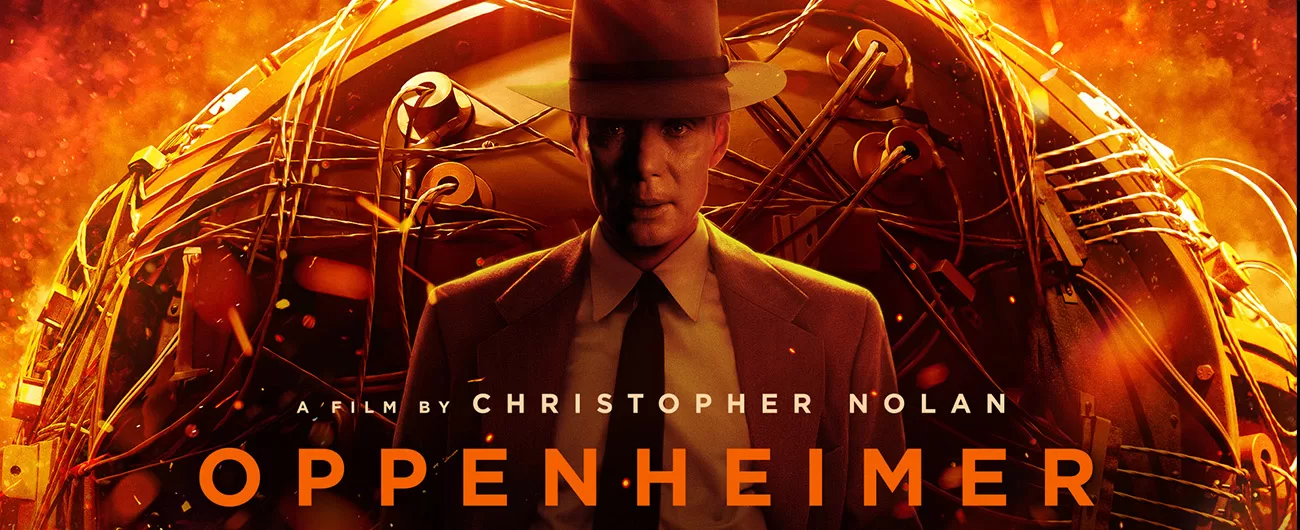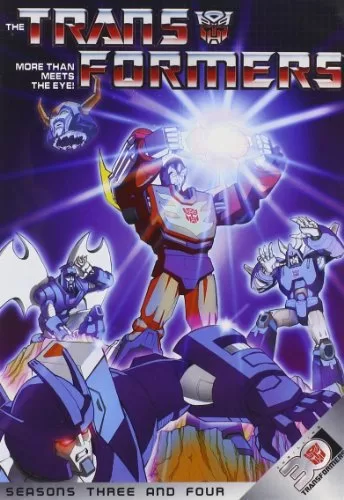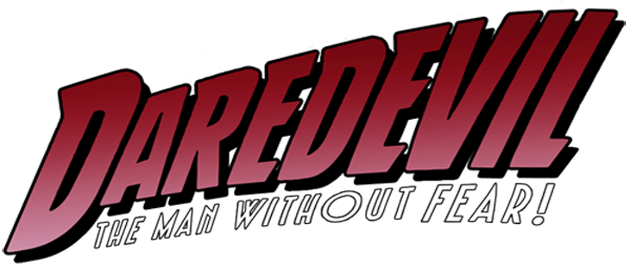
Devil’s Advocate: Daredevil: The Man Without Fear!
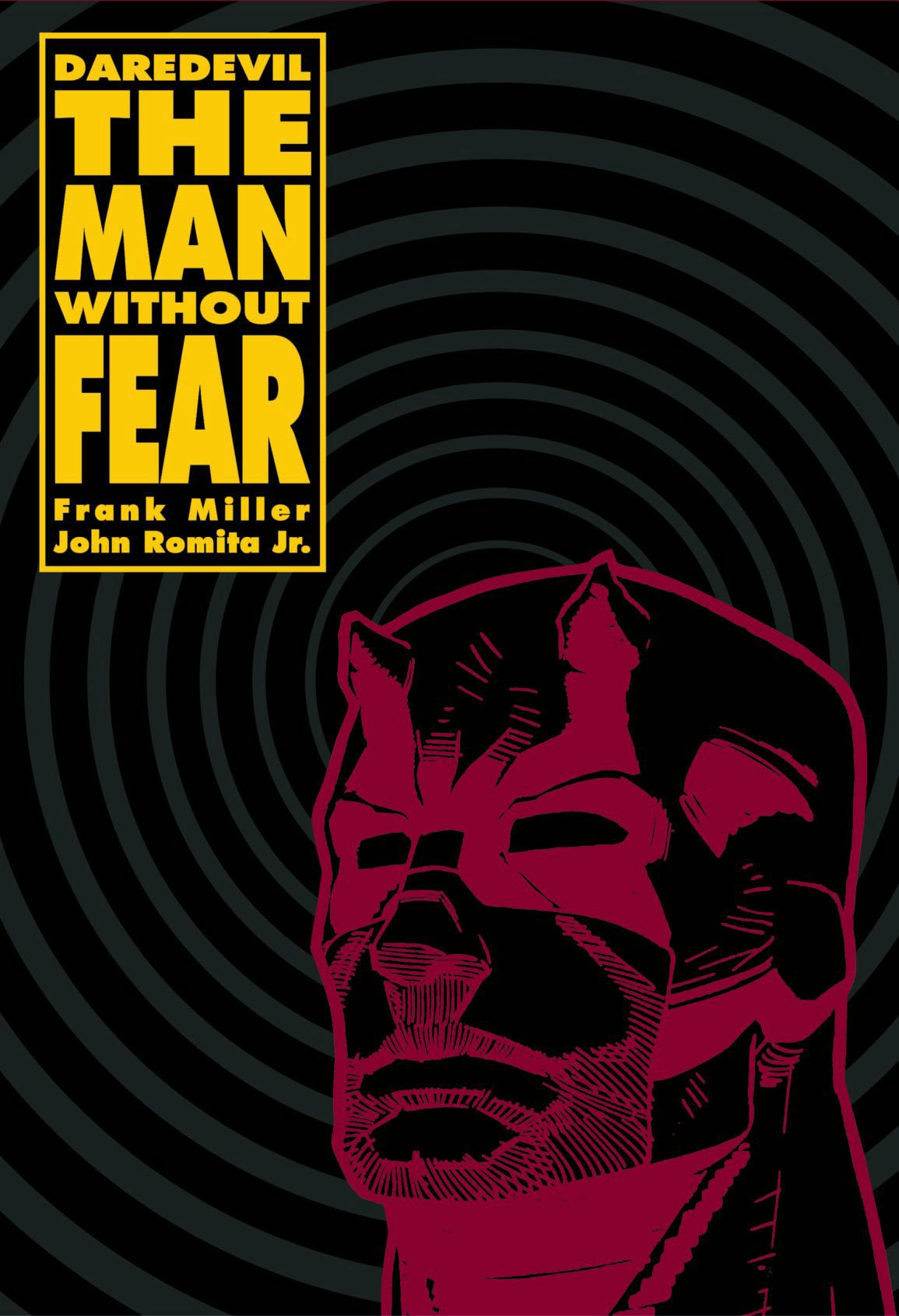 The problem with any long-running series is that eventually it runs into narrative snags over time. Character changes sometimes go too far, retcons are inserted into the character that cause damage or need to be reset, or other issues arise that disrupt the long-term character arc. One could look at any number of characters this has happened to, including established iconic characters like Spider-Man, Green Lantern, and the Hulk. Later these problems may be reset, usually by restoring the character to “factory” default settings, but these stories tend to cast a cloud over the character long after the matter is settled and done.
The problem with any long-running series is that eventually it runs into narrative snags over time. Character changes sometimes go too far, retcons are inserted into the character that cause damage or need to be reset, or other issues arise that disrupt the long-term character arc. One could look at any number of characters this has happened to, including established iconic characters like Spider-Man, Green Lantern, and the Hulk. Later these problems may be reset, usually by restoring the character to “factory” default settings, but these stories tend to cast a cloud over the character long after the matter is settled and done.
Daredevil is unique among established comic book superheroes in that he has never had to face this problem. In fact, he has been consistently well-written since his first appearance in 1964, despite being in the hands of numerous writers during that time. Even writers with a dubious reputation on other titles have managed to do well and even shine on Daredevil. Daredevil was one of the titles that placed Brian Michael Bendis on the map and established him as a star writer during the 2000’s. Ann Nocenti was well regarded mainly as an editor on the X-Men titles before her own memorable run during the 80’s, even more impressive because she was following Frank Miller. Most recently, Chip Zdarsky has told his own memorable storylines with the Man Without Fear, drawing on years of rich material while bringing his own spin to the character. Unlike many characters in the comic book pantheon, Daredevil’s entire publication history feels like a consistent narrative where the characters all change and grow consistently with each run.
Some of this is because of the character’s basic design, but not all. Daredevil draws on a powerful archetype and symbiology. Matt Murdock is an Irish Catholic who dresses up as the Devil to do battle with the criminal underworld of Hell’s Kitchen. Indeed, the very choice of Hell’s Kitchen is the perfect stomping grounds for such a hero, embodying Matt’s inner conflict with the devil lurking inside him. He is a lawyer who believes in the value of the law, but who breaks the rules when the law isn’t sufficient to bring justice. Daredevil embodies everything Matt resists within himself, but sometimes needs to express when the system doesn’t provide the answers. Matt’s arc is about how he wrestles with his inner demon, the Devil within him. Each run tackles this core theme differently, but all of them are in line with each other and the larger narrative.
“Devil’s Advocate” is intended to explore what sets the character of Matt Murdock apart by exploring his major story arcs and runs. Unlike the Claremont Retrospective, it doesn’t necessarily intend to be comprehensive or chronological in its approach. The general aim is to explore these stories and how they contribute to the Daredevil narrative, what they say about Matt Murdock and what meaning we can gain from them. Through this, hopefully the series can reach a larger understanding about what makes Daredevil such a consistent and compelling character through a deeper analysis of his stories.
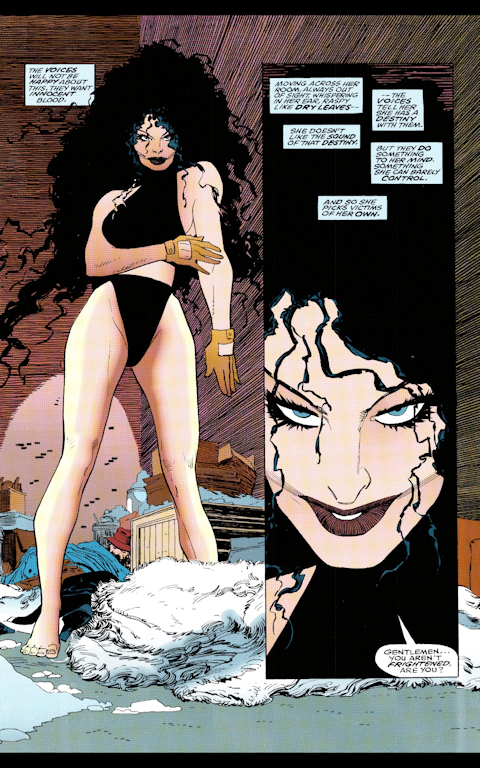
When it comes to accessible entry points into Daredevil and the series, Frank Miller is typically one of the first names to be mentioned. Most recommendations of good starting points into Daredevil will typically include Daredevil: The Man Without Fear, a five-issue mini-series that retells Matt Murdock’s origin story. However, this story also deepens the Frank Miller mythology on Daredevil, exploring Matt’s history with the assassin Elektra and his first battle with his arch-foe, the nefarious Kingpin of Crime. This is a book that captures the basics of the Stan Lee origin, while also serving as a prologue to the Frank Miller stories that were written earlier.
I’ve discussed Frank Miller briefly in the Claremont Retrospective, especially in my discussion of the original Wolverine limited series, which he illustrated and made significant story contributions. That book also had small connections to the Daredevil mythos, especially its involvement of the Hand, which Miller created for Daredevil previously. Even by that point, Miller was already synonymous with his work on Daredevil, his first hugely successful run as a writer and artist, and he had yet to hit even greater heights in his long career.
Although Miller is best known for writing darker and edgier anti-heroes, at his core, he isn’t a superhero writer—or at least, not a typical one. Miller’s strength and the genre he typically revisits is crime noir, a genre steeped in gritty, hard-boiled detectives, femme fatale villainesses, and ruthless criminals. Miller would eventually tackle his own version of noir in Sin City, but he made his career in writing noirish stories featuring urban vigilante heroes. Daredevil was the perfect playground for a writer like Miller, steeped in a dark, unforgiving city with a cast of characters that perfectly fit the noirish world that he envisioned. Also, as mentioned in the Claremont Retrospective, Miller was steeped in Asian influences at exactly the right time, embracing ninjas and Japanese mysticism right as Japanese storytelling was beginning to explode in the West. This combination of traditional superheroes with noir and Eastern storytelling was something unique at the time, and it remains quite possibly the definitive run on the character.
The Man Without Fear, while taking place at the beginning of Daredevil’s life as a crimefighter, was chronologically the last Daredevil story that Miller wrote. It was a story that was originally published in 1994, but it had evolved over the course of six years prior to that, surviving various changes to medium and content. The result was a story that became Frank Miller’s final statement on the character that had built his career. It is also perhaps the most accessible entry point to the character, as well as one of the most timeless stories that Miller ever told. One could see the Man Without Fear series as Daredevil’s answer to Miller’s Batman: Year One, also an accessible origin story that sets up the basics of the character. At the same time, The Man Without Fear doesn’t feel like Miller is copying himself, and Matt Murdock’s journey comes across as distinctly different than Bruce Wayne’s. Moreover, The Man Without Fear draws on much more iconic concepts than Batman: Year One does, featuring Daredevil’s greatest love interest as well as his greatest villain. Because of this, the story comes across as more of a missing chapter or a lost adventure rather than a retelling.
One may notice a few inconsistencies between The Man Without Fear and Frank Miller’s previous version of Daredevil’s origin during his run on Daredevil. Certain events don’t happen exactly the same way and other points of the narrative are new to the mini-series. This is largely because Miller did not originally intend The Man Without Fear as a comic book, but it was changed later to be one.
Initially, Miller intended the story that would become The Man Without Fear as a proposal for a Daredevil TV series back in the late 1980’s. At the time, Miller had already been moving through Hollywood, having scripted the Robocop 2 film. The Daredevil story written for television was initially titled “Blind Justice” and was a story presented in ten acts. Unfortunately, this proposed series fell through and was never greenlit. It’s possible that the timing simply wasn’t right then for a Daredevil show; at the time, there was a deep resistance to comic book adaptations, and it took many successful comic book films to change that. Eventually, a Miller-inspired Daredevil series was approved and became popular, which eventually became the Netflix Daredevil series. In an interesting turn of events, the Man Without Fear black costume was used for the show, showing how influential this book had become. In a way, Miller did manage to get the show he wanted and the story he wanted on the screen, if not the way he had intended.
After a conversation with artist John Romita Jr., who was interested in a Daredevil collaboration with Miller, Miller decided to restructure “Blind Justice” into a graphic novel. By that point, Romita had already made his name with his own Daredevil run with Ann Nocenti, and he had more than paid his dues on the character. (It’s also possible that Romita Jr. had a personal attachment to Daredevil for other reasons; his father, John Romita Sr., had a memorable run on the character in the Silver Age.) Likely, Romita and Miller had been friends even before then, having both been at Marvel for roughly the same amount of time. It’s also possible that since Miller had no plans of using the “Blind Justice” story elsewhere, and Hollywood would never do anything with it, he decided it best to adapt it as a comic book project. Editor Ralph Macchio (no relation to the actor) approved the project, and The Man Without Fear became a reality. In the end, the series debuted not as a graphic novel, but as a five-issue mini-series, though it would be collected many times over the following decades.
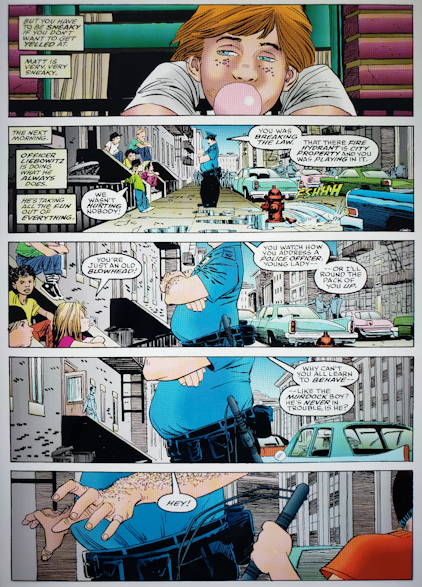
The first issue of The Man Without Fear focuses on the early life of Matt Murdock, growing up poor in the slums of Hell’s Kitchen. He grows up mostly by himself, the son of a boxer named Battlin’ Jack Murdock, who sometimes went by “The Devil”. Murdock could have made it big as a boxer, but fell on hard times, some of it self-inflicted. He falls into drink after his wife Maggie left him and vanished, and we eventually discover in Born Again (and alluded to in this series) that she has gone into a convent and become a Catholic nun. This leaves Jack struggling to raise his son alone, in difficult circumstances and at great personal cost.
It’s interesting, then, that Frank Miller decides to refer to young Matt as a “mischief-maker” and a troublemaker. This Matt acts like a good kid, while using a mask to hide some of his troublemaking. We see, for instance, that young Matt dons a mask and goes skateboarding, eventually stealing the nightstick of a police officer named Officer Liebowitz. He later hides the nightstick he took from the policeman, hiding it in his locker at Fogwell’s Gym. It’s an effective bit of foreshadowing as much as it is a character-building piece for Matt Murdock; Matt will eventually retrieve the nightstick in a later issue, serving as a predecessor to his standard billy club weapon.
There’s a popular perception among Daredevil fans that Frank Miller is best known for making Daredevil a darker and grittier character. This is certainly true to an extent; Born Again especially is regarded as the story that deconstructed Matt and tore everything away from him. At the same time, we see in this series that Miller has not entirely rejected the swashbuckling element of the Daredevil that Stan Lee created. Matt Murdock is a mischievous character to some extent, and he delights on some level in toying with the evildoers that he fights. This is an aspect of Daredevil that later runs would reference from time to time, especially the more light-hearted versions like the Karl Kesel and Mark Waid versions.
For Miller, though, the mischievous side of Matt is connected to the side of himself he tries to suppress beneath layers of self-imposed rules. He plays Matt as emotional and impulsive, given to bursts of anger and violence at times. Miller also establishes where this comes from; Matt is very much his father’s son, and Jack Murdock was a fighter by nature. However, Jack Murdock was not able to change, and by the time he realized what he’d settled into, it had become much too late to save himself. By then, he had been coerced by a criminal called The Fixer into becoming a thug and a criminal debt collector. Jack realizes that he cannot save himself; he must do what he can to protect Matt from the life he leads, keep him alive until Matt can earn an honest living. This leads Jack to pushing his son away from the path he’d chosen, convincing Matt to live an honest life, away from the violence and criminal behavior that marred his own life.
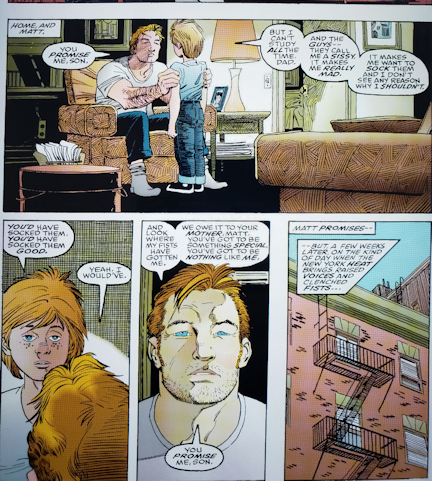
Matt makes a solemn promise to his father, one that would define his entire life. Matt promises that he will never become a man like his father, one who uses his fists. He promises to make something of himself, become the man that Jack Murdock never could. In time, this leads Matt towards becoming a lawyer, a career that represents the dreams of Jack Murdock. However, Matt is too much his father’s son, and he gives in to his violent urges, defending himself against a bully that had hit him. Jack grows angry and hits Matt in a fit of rage, as both men give in to their worst impulses. But this incident also makes Matt realize how much rules are necessary, and it inspires Matt to learn the rules and become a lawyer.
Not long after this, Matt reaches the fateful day where his path is defined. An old man crosses the road, about to be struck by a truck carrying barrels of chemical waste. The idealistic Matt lunges across the road, saving the old man from the truck, but he’s struck by the chemicals in the process. Matt survives, but he is blinded by the chemicals, which have changed him forever. He loses his sight for the rest of his life, but he gains new advantages. All of Matt’s remaining senses are heightened to superhuman levels—his hearing, smell, taste, and touch are all beyond human. Moreover, Matt would also acquire his special “radar” sense, allowing him to make out shapes around him, much like echolocation. Miller doesn’t focus so much on his radar sense openly, tending to regard it as more a mystical ability, though it is a long-established part of Daredevil’s power set.
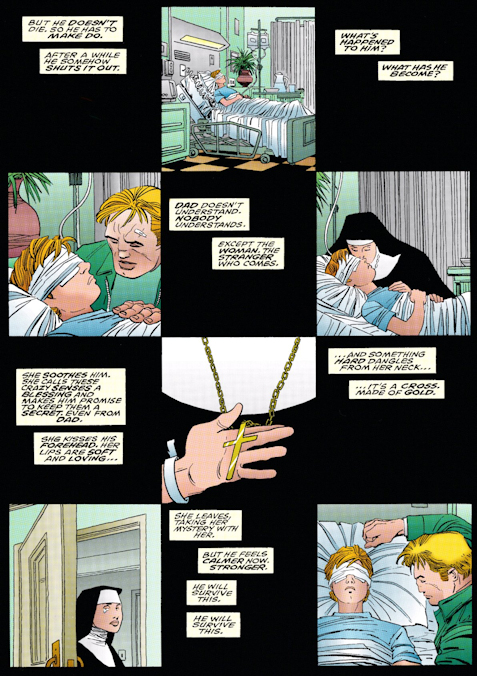
Miller also explains why and how Matt keeps his new powers a secret. Matt’s mother visits him in the hospital while he recovers from his injuries. She does not tell him the truth about their relationship; to Matt, she is a mysterious stranger who wears a cross of gold. Miller and Romita make this clear to the reader, though, as the “stranger” looks exactly as Sister Maggie did in Born Again. Matt cannot see what the reader does, nor does he know very much about his mother, knowing her only as a picture that his father obsesses over from time to time. We see that Maggie still loves her son and watches over him from afar, though she cannot break her vows to her order or return to her old life with Jack. Just as Jack represents the violence within Matt, Maggie represents Matt’s commitment to justice and to God. Matt’s Catholicism is a large part of his character, as it guides his moral values as well as how he defines his relationship with his own dark side. Maggie is a character who embodies that side of Matt, the side who tries to do good regardless of his own failings. It is Maggie who encourages Matt to keep his powers hidden, presumably to keep him safe from those who would exploit him. This advice ends up helping Matt in the long run, because it helps him to maintain his secret identity for years.
Not long after his release from the hospital, Matt is approached by Stick, who ends up becoming his mentor in the martial arts. As we learn in Miller’s run on Daredevil, Stick is the leader of The Chaste, a holy order of martial artists with abilities that are near-mystical. Stick is an avowed enemy of The Hand, a ninja clan that serves a demonic being known as The Beast. Although Stick explains little of his reasoning to Matt, his main concern is training a young acolyte that will eventually join The Chaste and continue their teachings into the future. The current members of The Chaste are growing old, while The Hand grows more numerous. Only two young adepts in this generation have the potential to learn the ways of The Chaste—Matt Murdock and Elektra Natchios. Stick, however, is concerned about Elektra, since she has also been chosen by The Hand, and fears that she may be corrupted by his ancient enemy. Because of this, Matt Murdock has the most potential in Stick’s eyes to join The Chaste, though Stick is concerned about his emotional and unruly nature.
At first, it seems as though Matt is making progress as Stick’s apprentice. Stick trains Matt in the ways of The Chaste, though this learning goes beyond simply learning martial arts. Stick was born blind, and because of this, he has learned to fine-tune his mystical senses to operate in pure darkness. He likewise teaches Matt to fight and move in blindness, helps Matt to hone his super-senses so that he can fight effectively. Stick, however, is a cruel and demanding teacher, expecting nothing short of perfection and accepting no excuses for failure. He stands in stark contrast to Matt, cold, unemotional, brusque, and extremely unforgiving. Still, Matt learns a great deal from Stick, and Stick’s relentless prodding forces Matt to improve himself at tasks a normal blind person would find impossible. However, Matt never gives up no matter how many times he’s beaten down, a trait he learned from his father.
This is a trait that ends in the death of Jack Murdock. Towards the end of his life, Battlin’ Jack was starting to hit the rebound as a prizefighter. He had won six major bouts in a row, and he was ready for one last big fight in Madison Square Garden. However, Jack’s good fortune had an underlying reason; The Fixer was rigging all the bouts in Jack’s favor, eventually planning to make money from Jack’s big defeat. Fixer demands that Jack throw the last big fight so that he can cash in on the loss. However, Jack refuses—as tarnished as he is by the sacrifices he’s made for Matt, he will not throw his pride away and he will never be a quitter. He will not compromise on this one thing, because he wants Matt to know that his father refused to quit, even at the cost of his own life. Jack knows the Fixer will kill him for this, but he doesn’t care. For Jack, this is a battle worth dying for, and he wants to go out as a fighter and not the man the Fixer has turned him into. Jack wins the last fight and pays the consequences for his last ounce of principle. The issue ends as Jack is taken by the Fixer’s goons after the fight and savagely murdered.
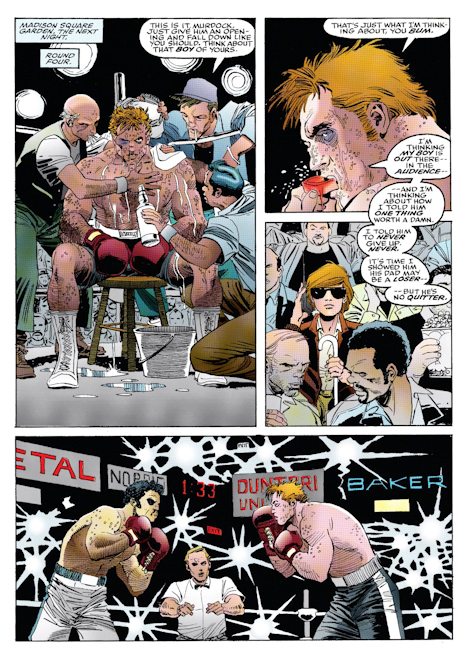
The second issue begins with Matt identifying the body of his father at the morgue, consumed with cold rage. The story wastes no time as Matt Murdock begins his roaring rampage of revenge against the five men who murdered his father. With his powers, he has no trouble finding and identifying who each of them are, and then inflicts brutal justice upon each of them. At this point, he still is not truly Daredevil, though his father’s killing is certainly one of the most important catalysts. His actions are not driven by Matt’s desire for justice and his belief in the law, but by his thirst for revenge and need for violence as an outlet for his pain. He is also not thinking about the consequences of his actions, and his decision to avenge his father eventually backfires on Matt terribly.
Matt does show a certain amount of restraint, but it isn’t enough. He decides consciously to let these people live, though he beats the killers into submission. However, the consequences lead to unintentional deaths, deaths he might have avoided with more experience and less emotionally driven thinking. The Fixer dies of a heart condition, presumably triggered by his fear of Matt’s wrath and the extreme physical exertion of running away. One might argue that the Fixer’s death is deserved, given his involvement in Battlin’ Jack’s murder and his numerous other crimes as a mobster. However, Matt’s rampage also ends in the accidental death of a young woman; Matt was defending himself against her while she was trying to protect one of the killers. The battle gets out of hand, and then Matt kills her by knocking her through a high window. The girl falls to the street and ends up dead, an action that haunts Matt for years after this.
There are other indirect consequences, as Stick disappears for good, and Matt does not see him until many years later. Stick believes that Matt’s emotional and undisciplined nature makes him too dangerous to continue to train. Following Matt’s rampage of violence, Stick has a conversation with his right hand in The Chaste, Stone, about his decision to abandon Matt as a pupil. Stone is more of a realist, and he believes that new blood is needed for The Chaste to survive as an order. Stone reminds Stick that there are only two adepts—Matt and Elektra, and Elektra has been tempted into darkness by The Hand. He pleads for Stick to allow Matt another chance, but Stick is resolute. He refuses to allow the risk that the order of The Chaste itself might be compromised. In Stick’s mind, Matt has failed his test, and there is to be no further training and no path for Matt Murdock into their brotherhood. Matt is left alone with the skills left to him by Stick and by his father, and he resumes his law studies.
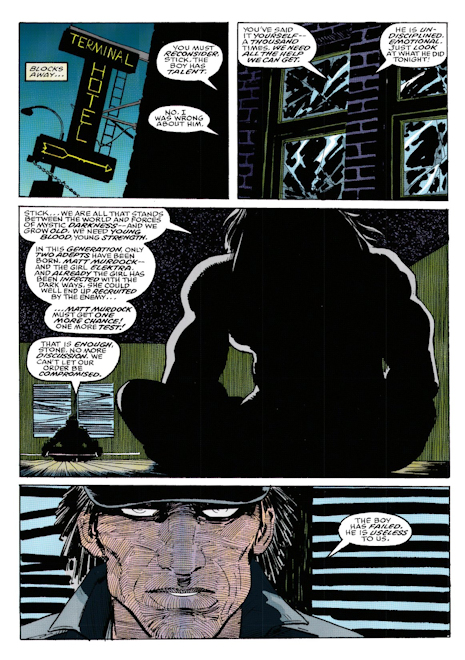
The action flashes forward, where Matt Murdock has entered law school. By this time, Matt has already met Franklin “Foggy” Nelson, his best friend and eventually, his law partner and confidant as Daredevil. Foggy Nelson is an important character in Daredevil’s life, mainly because he is the voice of reason that Matt often needs. Sometimes Matt is impulsive, excessively risk-taking, even a bit arrogant, and Foggy is none of these things. He is typically laid-back, relaxed, and more involved with research and investigation, things that Matt often needs Foggy’s practical advice about. At the same time, Foggy shares Matt’s commitment to justice in his own way, though he tends to express this more through his skills as a lawyer and a legal scholar. Their relationship complements both, as Matt can protect Foggy from physical danger, while Foggy protects Matt from his own impulsive behavior. Foggy is one of my favorite non-powered supporting characters for all these reasons, and he is certainly one of the most essential characters in the Daredevil mythos.
This issue helps to establish why Matt and Foggy were friends in law school, and how that friendship gradually grew to a long-standing partnership between the two men. When Foggy is bullied by a college rival, Matt becomes angry; as someone who was bullied as a child himself, Matt despises bullies. Matt usually is the one who protects Foggy from bullies, though taking care not to reveal his secret as Daredevil even to his best friend. They also spend their college years as roommates, very often studying together in law school.
Matt is also much more guarded around this time, but he’s not immune to temptation. With most girls, Matt is extremely defensive in his approach to them. This is not because he’s afraid of them, but because he’s afraid of what might happen if he loses control again. The death of the girl earlier in the issue weighs on Matt’s mind still, and he doesn’t want his loss of control to have any more victims. Still haunted by this, he brushes off a girl named Cathy, a classmate of his, and one of many love interests that ends up being drawn to Matt over the years.
Matt becomes far less guarded when he finally meets Elektra Natchios, who eventually becomes his girlfriend during his college years. Elektra is arguably Frank Miller’s greatest creation, a ruthless assassin who is only truly restrained by her feelings for Matt Murdock. Miller has always had an eye for femme fatale anti-heroines and villainesses, perhaps because these characters are such a strong staple of the crime noir genre. Still, Miller has created or worked with many of them—Yukio from the Wolverine mini-series, Catwoman, and many of the women from Sin City belong to the same archetype. However, Elektra is the perfection of the archetype in the hands of Frank Miller, as enigmatic and tempting as she is deadly. She is such a strong character that she’s spun off into her own series, most notably the outstanding Elektra: Assassin by Miller and Bill Sienkewicz.
The Man Without Fear would be Elektra’s final appearance as written by Miller. In fact, she was not originally slated to appear in this series at all originally. She did not feature in the original treatment for “Blind Justice”, which is odd given how Miller is so deeply associated with the character of Elektra. However, when Miller revisited the project as a graphic novel, he decided to expand the background of Matt Murdock’s origins, including his past with Elektra in college. This ended up making The Man Without Fear a deeper and more comprehensive look at Matt Murdock, as his relationship with Elektra is an important piece of the Daredevil mythos.
At first, Elektra plays a dangerous game with Matt in the park, using her clothes to string him along and lure him where she wants him to be. The game ends when Matt is found by two police officers, and he’s forced to surrender to them. Matt could easily break free of the two cops, but he doesn’t want to break the law and risk hurting someone else. This is one of the main differences between Matt and Elektra—where she has no rules and takes pleasure in her violent side, Matt restrains himself and obeys the law out of fear of harming others.
Matt encounters Elektra again the following day, where she drives past in an expensive car. Matt decides to hitch a ride with her, and she drives him to a snow-swept cliffside. Elektra lives vicariously off the thrill, the rush of adrenaline that comes with living on the edge. On some level, Matt does as well, which is why the two inevitably become drawn to each other. Unlike Elektra, however, Matt has some restraint and some regard for the consequences of that kind of lifestyle. He is tempted by Elektra, and he is tempted by the freedom that she offers him. At first, Elektra leaps from a cliff, and Matt leaps after her, thinking she might die because of him. This is a fear that haunts him consistently over the years, but here, it’s part of the game that Elektra is playing with Matt.
When a drenched Matt returns to his dorm, Foggy attempts to warn Matt about Elektra, all to no avail. Matt is now completely captivated by Elektra, and he’s driven to learn more about her, whatever the risk to himself. Still, Foggy is a good friend, and his advice to Matt has real merit. Elektra is truly dangerous, and Matt is blind to her real nature. Indeed, Miller is playing the concept of blindness on a double level—Matt suffers from physical blindness, but he is also so blinded by his feelings for Elektra that he can’t recognize the danger she represents. Indeed, it’s even possible that Matt is drawn to Elektra because she’s so dangerous, because she revels in who and what she truly is in a way that he never can. Elektra has the same capacity for violence as Matt does, has the same Chaste training that he does, but she goes to depths Matt never will—she has no reservations about killing to satisfy her urges.
The following scene shows Matt as he attempts to break into Elektra’s home, while Elektra is entertaining her father’s guests at the piano. Miller engages in a very strange way of building sexual tension between Matt and Elektra, playing Matt’s violence during the break-in against Elektra playing music at her father’s party. The crescendo of Elektra’s performance builds to a climax, implying almost that Elektra is turned on by the violence that she knows Matt is dealing out elsewhere in the house. It’s never clear how she knows this is happening, presumably some sort of ninja mysticism, but she acts as someone who’s fully aware of what Matt is doing. She even rewards it later, by coming to Matt’s dorm and spending the night with him. From then on, Matt and Elektra are officially a couple, though Matt is still blind to the woman he’s truly involved with.
Following her time with Matt, we see Elektra as she stalks five street thugs and eventually kills them. Miller refers to Elektra hearing voices and feeling urges, and this scene likely will not be clear to anyone who hasn’t read Miller’s previous Elektra stories. Although the idea of hearing voices would imply insanity, and Elektra’s father seems to think so, these voices are in fact real. Elektra is likely hearing the voices of either The Hand or their master, The Beast, the demon that the ninja clan serves. By killing these thugs, she is defying The Hand by killing only the guilty, rather than murdering the innocent as The Beast desires. Elektra continues doing so for some time, and this path leads her eventually to bounty hunting as well as assassination. However, the game she plays with Matt has a consequence she doesn’t intend—what began as a game has turned to love. Elektra is internally torn, wanting to be with Matt but unwilling to put him at risk because of her violent and murderous nature.
The relationship between Matt and Elektra proves to be unsustainable. Stick ambushes Matt in his dorm at night, warning him to stay away. “That girl is poison,” Stick warns. “She’s on her way to the worst side, and she’ll drag you down with her. It’s bad enough you failed me. I won’t have you joining the enemy. I’ll kill you first.” Matt refuses to listen, still enthralled by Elektra’s charms and unwilling to leave her. In the end, it’s Elektra that finds the strength to walk away from the relationship. After her father dies, she leaves Matt at his graveside, not wanting him to be dragged down where she must go. “I will do this much right—I will leave you,” Elektra tells him. “I will go to Hell alone.” Elektra departs, and Matt does not see her again until years later, long after he’s become Daredevil.
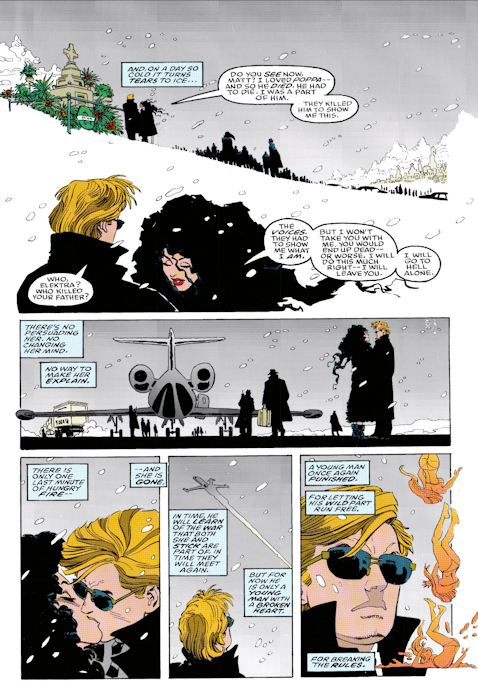
The two remaining issues of The Man Without Fear centers on Matt Murdock’s first encounter with his future archnemesis, the Kingpin. By this time, Wilson Fisk has only recently taken power in the New York underworld, controlling all of crime in Hell’s Kitchen. Fisk is virtually untouchable even this early on, and Matt never directly confronts the Kingpin at any point in this series. However, this story does establish Matt as the Kingpin’s enemy, opposing the Kingpin’s operations and opposing his minions. Fisk is an appropriate choice for a master villain here, given how instrumental Miller was in building him up as Matt’s greatest enemy. This story helps to establish how the two became such implacable and bitter foes, focusing on the beginning of their years-long hatred for each other. To Matt, the Kingpin is the ultimate bully and the worst kind of lawbreaker, the kind that preys on the weak to fatten himself. Meanwhile, Fisk regards Murdock as an opponent to be crushed, a man who has actively destroyed his business and his lifestyle. In many ways, Fisk is the perfect noir villain, reflecting villains such as those played by Sydney Greenstreet in noir films like The Maltese Falcon.
The setup for this story is basic, and in many ways the kind of crime story that Miller is known for. It’s quite possible that this structure is the meat of the initial “Blind Justice” treatment, which also focused on Daredevil’s battle with the Kingpin. Matt returns to Hell’s Kitchen after passing the bar and becoming a junior partner at a Boston law firm. While there, he meets a teenaged girl named Mickey, though this is an alias; her real name is Dominique Moran. This name is an interesting choice by Miller, very possibly a sly nod to Alan Moore’s Miracleman (whose real name was also Mickey Moran). Matt and Mickey become friends, spending time in old Fogwell’s Gym where Matt grew up.
The friendship between Matt and Mickey is an interesting one. Mickey is someone who spent much of her time in Matt’s old stomping grounds in Hell’s Kitchen, and lives much as Matt himself did at one time. Matt is open with Mickey about many of his secrets, and he lets his emotional control lapse a bit around her. Quite possibly he does so because he sees himself in Mickey; she’s the mischief-maker that he was at her age, in addition to their shared experiences in Hell’s Kitchen. Mickey’s dealt with bullies much as Matt has, and Matt sympathizes with those who are bullied. In turn, Mickey looks up to Matt as someone who was raised in the Kitchen and did well for himself. She clearly admires Matt, perhaps even looks up to him. For Matt, she becomes his reason to focus less on his job at the Boston law firm and focus on helping people in the old neighborhood.
However, Mickey becomes a target of the Kingpin’s men, who are looking for young girls to use for Fisk’s snuff film industry. Miller addresses a very sordid and ugly topic, but he handles it quite tastefully, likely due to Marvel’s policy at the time and the Comics Code they followed until the 2000’s. In any case, Mickey is kidnapped, and the remainder of the story centers on Matt’s effort to rescue Mickey from the Kingpin and his people. The internal politics of the Kingpin’s organization is interesting, as Miller shows how low-level criminals cause unintended damage to the bosses within organized crime. This, in turn, prompts the Kingpin to use deadlier and more extreme methods to silence the people involved and to protect himself from the resulting blowback. In the end, Kingpin is forced to send Lark, at the time his right hand operative, to remove Daredevil from the equation and settle the mess.
Eventually, Matt discovers that Mickey has been kidnapped, and he truly becomes Daredevil for the first time in the series. After finding Mickey’s hat that she always wore, he finds her address, then uses his senses to listen in on her parents. When he finds them, they are on the phone with the kidnapper, and Matt hears the entire conversation. Fueled by concern for the girl, he makes a fateful decision. In a callback to the first issue, Matt returns to Fogwell’s Gym and recovers the nightstick that he stole from Officer Liebowitz as a child. The nightstick is important symbolically, as it represents the long arm of the law. It stands for Officer Liebowitz and what he stood for—rules, honesty integrity. It is a weapon used to serve Matt’s idea of justice. It represents Matt’s ideals, his belief in the law and the side of him that values rules and justice. It’s a blunt weapon and thus Matt sees it as being used to save lives. The nightstick also works in the same way as Matt’s billy club, the iconic weapon that he uses as Daredevil. He also dons the black costume for the first time, the outfit that is most associated with this series.
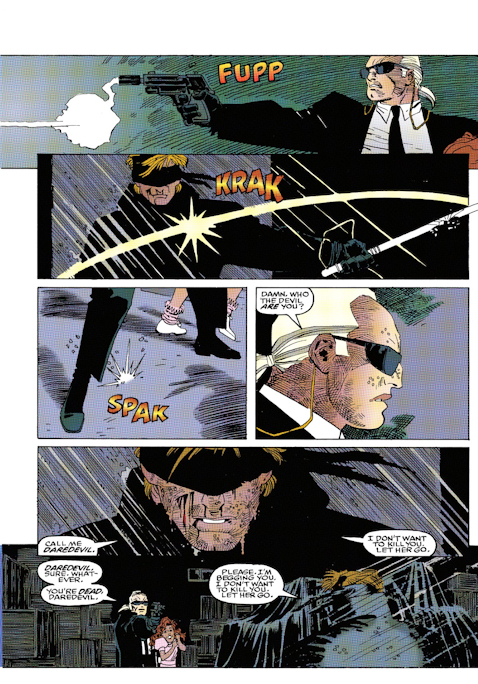
The final confrontation between Daredevil and Lark shows the growth of Matt Murdock, and it is the culmination of all the lessons that he’s learned. Lark holds Mickey at gunpoint, threatening her in a last-ditch effort to protect himself. Matt keeps his emotional control during the entire confrontation; he fears losing control and Mickey dying because of his anger and impulsiveness. He has no regard whatsoever for Lark, who he sees as a bully, but Lark is holding Mickey as a hostage. So Matt offers every chance for Lark to surrender, to let the girl go, to walk away, though he’s fully prepared to fight if necessary. Lark refuses to back down, and Matt reacts defensively, using the policeman’s nightstick to deflect the bullet. Lark fires at Matt, and the bullet bounces back towards Lark, killing him while sparing Mickey. The nightstick is destroyed by the gunshot, and in a way, Officer Liebowitz ends up protecting one last innocent in Hell’s Kitchen. It’s Matt’s sense of control, his belief in the law, that overcomes the Kingpin and saves the girl from his clutches.
By the end of this story, Mickey is rescued, Lark dies in battle with Daredevil, and Matt Murdock has truly become Daredevil, though he has not yet donned the devil costume officially. We never truly see Murdock in costume until the last page, where Romita Jr. shows Daredevil in action as the man he will become. By this time, we also see Stick come to terms with Matt, even if he will not accept him as a member of The Chaste. Still, Stick does show some affection for Matt and a certain respect for his actions, even if he still keeps his distance from Matt for some time following this. The story ends where Daredevil’s story truly begins, with the beginning of the Nelson & Murdock law firm and Daredevil’s legend only beginning to grow in the New York underworld.
We never see Mickey Moran again after this, and it’s honestly a shame. She is a good character in this story, and she plays off of Matt’s character quite well. She isn’t merely a girl hostage in this story either, as she actively does her best to escape from the Kingpin’s men and help Matt to locate her. It would be interesting to see her again as an adult and re-enter Matt’s life in a future Daredevil story. She certainly seems to have kept his secret all this time, and she relates to Matt, having grown up in a similar environment. Regardless, Mickey is another interesting Frank Miller character who could easily amount to something in the right hands. Perhaps we may yet see her again one day.
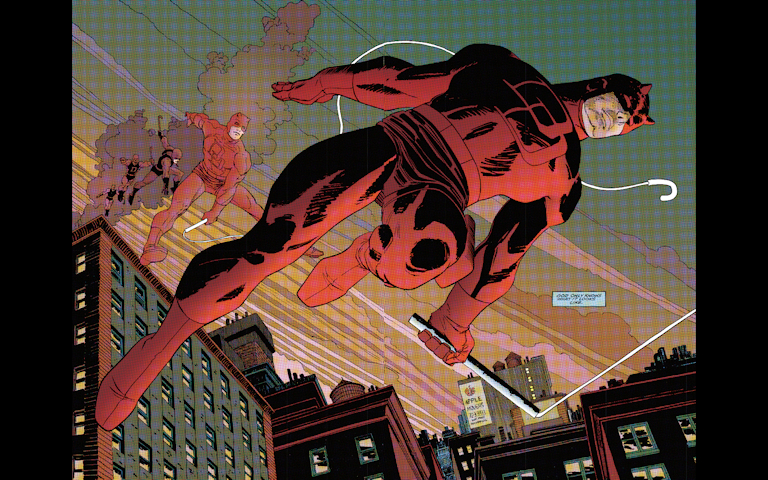
Daredevil: The Man Without Fear may not be Frank Miller’s greatest Daredevil story. He can be easily forgiven for that given how many great stories he’s written and drawn over the course of an amazing career in comics. This story is, however, the perfect entry point into Daredevil, as it sets up his most important and enduring characters and enemies. It also drives hard to the point of Daredevil’s character, his conflict between everything noble about Matt Murdock and his capacity for violence and deception.
This story is also an excellent prologue for Frank Miller’s run on Daredevil and his Elektra stories, as it alludes to them without giving away too much about them. As much as the original treatment focuses more on Matt’s origin and his battle with the Kingpin, some of the most interesting points in this series revolve around Stick, The Chaste, The Hand, and Elektra. Matt’s temptation shows him at his most human, as a man driven by love into blindness, trying to find his way out of the darkness. The Miller ninja stories are easily Miller’s most enduring contribution to the series aside from the Kingpin, and this story serves them well as a prologue chapter.
In short, The Man Without Fear is a good, simple primer on the Daredevil mythos. If you’ve never read anything about the character before, I’d most strongly recommend this series. Frank Miller is one of the greatest writers ever to work with Matt Murdock, and those finer points are represented in the mini-series. The series provides a clear grounding about who the character is, his inner conflict, and the major figures in his life, while also being a simple and digestible story. This book is also illustrated by two highly renowned artists, John Romita Jr. and Al Williamson, two industry veterans who have done praiseworthy work on the character even before this series. Their work is outstanding on this title, with very crisp and clean storytelling that captures Miller’s vision wonderfully.
Part of the success of Daredevil as a character is shown by how strong his foundation is, and Man Without Fear illustrates this clearly. Matt Murdock is a complex and flawed hero who is admirable while also having a dark side he tries to control. His villains effectively contrast him and reflect those temptations in dramatically compelling ways. Because the foundation of the character is so well designed, future writers have had a deep tapestry to build on. This mini-series illustrates the depth of that foundation, offering future writers a broad canvas to explore.
Author Profile
- Steve Sellers had been a fan of superheroes ever since Superman: The Movie. But it took the JSA, the Legion of Super-Heroes, Dragonlance, Lord of the Rings, Twilight Zone, and Chris Claremont's legendary run on the X-Men to make him a writer and a longtime fan of comics, fantasy, and science fiction. Steve is the co-creator of WHITE DRUID & MICHAEL NERO and GUARDIANS OF ELAYIM for Omen Comics, and he is also the creator of BLITZ and SHOCKWAVE for Revelation Comics (an imprint of Omen Comics).

